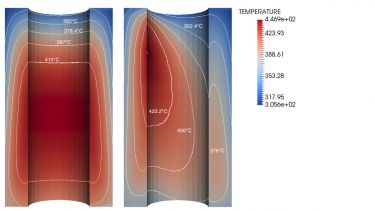Computational Study of Flow and Heat Transfer relevant to Nuclear Reactor Applications
This research has been funded by EDF over a number of years through research contracts and a PhD studentship.
Researchers: Dr. Jundi He, Prof. Shuisheng He
Collaborator: Dr. Bing Xu (EDF)
Numerical studies on nuclear thermal hydraulics were carried out in this project. The research project contains two stages: The safety case of an aged advanced gas-cooled reactor (AGR) was investigated at the first stage, and fundamental studies on the turbulence and heat transfer characteristics of vertical pipe flows of supercritical fluid were carried out at the second stage.
At the first stage, investigations on the effect of fuel channel eccentricity, graphite thermal conductivity models and horizontal mass leakages have been conducted, to provide end-of-life support for the AGR fuel channel at Hinkley Point B. Fuel channel/stringer eccentricity happens at the end-of-life of an AGR due to several reasons, including graphite cracking and shrinkage (weight loss), the study aims at investigating the effect of fuel channel eccentricity on the main brick temperature at different life time of the AGR.
At the second stage, turbulence and heat transfer characteristics of upward supercritical fluid flows were studied using direct numerical simulations (DNS). The mechanisms of laminarisation caused by the buoyancy and variation of viscosity is studied. A unified explanation was developed to characterise the laminarisation, and the apparent Reynolds number approach was applied to predict the flow and turbulence in an heated upward flow. Furthermore, the assessment on one of the fluid-to-fluid scaling approaches was carried out using DNS, and the effect of conjugate heat transfer on supercritical fluid flow was investigated. In this project, a branch version of the in-house DNS code CHAPSim was developed to implement conjugate heat transfer.
Publications
- He, J., Yan, J., Wang, W. and He, S., 2018. Direct numerical simulation study for fluid-to-fluid scaling for fluids at supercritical pressure. In International Heat Transfer Conference Digital Library. Begel House Inc..
- He, J., He, S., Xu, B., 2018, October. Effect of channel distortion and different graphite thermal-conductivity models on the prediction of graphite temperature. In 6th EDF Energy Nuclear Graphite Conference.
- He, J., He, S., Xu, B., 2019, August. CFD Studies of Effect of Fuel Channel/Stringer Eccentricity in the Core of an Advanced Gas-Cooled Reactor. In 18th International Topical Meeting on Nuclear Reactor Thermal Hydraulics (NURETH-18).
- He, J., Yan, J., Wang, W. and He, S., 2019, July. A DNS study of turbulence structures of flow of fluid at supercritical pressure. In 11th International Symposium on Turbulence and Shear Flow Phenomena, TSFP 2019.
- He, J., Yan, J., Wang, W., Jiang, P. and He, S., 2020. Effects of buoyancy and thermophysical property variations on the flow of supercritical carbon dioxide. International Journal of Heat and Fluid Flow, 86, p.108697.
- He, J., Tian, R., Jiang, P. and He, S., 2021. Turbulence in a heated pipe at supercritical pressure. Journal of Fluid Mechanics, accepted.
- He, J., Xu, B. and He, S., 2021. The effect of conjugate heat transfer on the flow of supercritical carbon dioxide. In 17th UK Heat Transfer Conference, under review.


